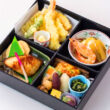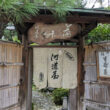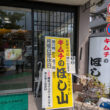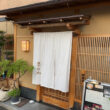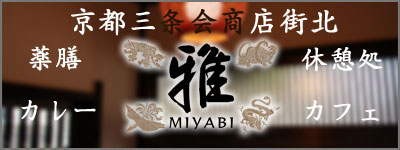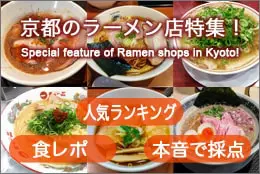The Current State of Kyoto Catering Services
Posted date:2025-10-06Author:つばくろ(Tsubakuro) Transrator:ポンタ(Ponta)
Category:Kyoto Gourmet , Talk about Kyoto
広告
adsense4
To begin with
The streets of Kyoto which are packed with tourists from overseas, pushing and shoving as they crowd in.
Whether walking through the city streets, riding the city bus, or taking the subway, foreigners can be seen everywhere.
Such scenes have long been commonplace, but it has become apparent that a significant shift is occurring in Kyoto’s traditional food culture, particularly regarding facilities where overseas tourists stay.
The columnist noticed it about half a year ago.
It was while I was walking through the neighborhood near my house, just as usual.
The Shijo Omiya area where I live in has seen a dramatic increase in business hotels and private lodging over the past decade.
Located in the city center, it boasts excellent transportation access to anywhere while also maintaining the character of a quiet residential neighborhood – that’s likely why small business hotels and private lodgings catering to foreign travelers have clustered here.
Well, one spring morning, as I walked down an alley one block off Shijo Street, the main thoroughfare, I spotted a boat piled haphazardly with empty dishes left behind after a meal in front of a certain private lodging.
They weren’t the remains of empty plastic lunchboxes, the kind you’d expect to find discarded at a convenience store or supermarket.
Whether it’s the venerable Kiyomizu ware or Kyoto ware, the numerous pieces of tableware – obviously expensive at a glance – are scattered carelessly, empty, aboard the ship.
And on the stern of the ship were the characters “Iden.”
Upon seeing these characters, the columnist realized that the catering business representing Kyoto’s food culture had apparently undergone a significant transformation.
When it comes to “Iden”, it’s located right next to Nishiki Market and is one of the foremost long-established catering establishments in Nakagyo Ward.
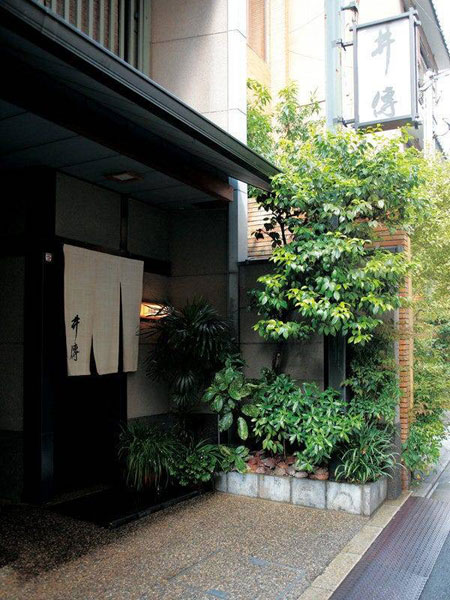
The front entrance of “Iden.”
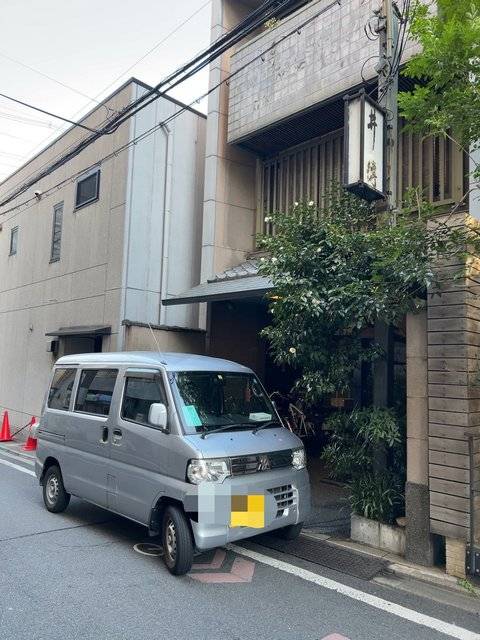
The wagon parked in front of “Iden”
It is a true catering house that has earned the trust of customers by delivering cuisine to households in Nakagyo and Shimogyo Wards, catering to the tastes of townspeople on special occasions, everyday meals, or as a secondary kitchen for large establishments.
Why did that “Iden” start delivering meals to private lodging?
At that time, the columnists found it puzzling but couldn’t quite figure it out.
However, before long, I encountered a similar scene once again.
Once again, it was in front of another private lodging in the back alley just off the main street.
And the name of the caterer written on the boat at that time was “Tujidome.”
This is also one of Kyoto’s premier catering services, specializing in delivering traditional kaiseki tea ceremonies from Higashiyama Sanjo.
Furthermore, for the third time, even the boat of the famous caterer “Kino Fu” on Muromachi Street in Shimogyo Ward.
This doesn’t seem like a mere coincidence no matter how I look at it.
What exactly is the state of Kyoto’s catering culture these days?
I’ve researched this topic and will now explain it.
What is catering service?
Caterers, the bearers of Kyoto’s unique food culture.
It’s not takeout, it’s not delivery, it’s not catering – so what exactly makes it unique?
It could be said that their motto is “to deliver cuisine that meets any customer request.”
For example, Kyoto catering services will prepare and deliver even a single dish, such as an appetizer to accompany sake.
In fact, records remain showing that the aforementioned “Iden” delivered one type of sake accompaniment to the Sugimoto family”, a major merchant house on Muromachi Street.
Another distinctive feature of catering services is that they deliver dishes beautifully arranged on exquisite tableware.
Furthermore, customers who have finished eating don’t even have to bother clearing away empty dishes; they can simply leave the bowls on the boat and bring it out to the entrance. The cleanup is handled by the catering service, who come to collect the dishes.
They cook for you, serve it on fine tableware, and you don’t have to worry about the troublesome cleanup afterward. A restaurant offering the most attentive service imaginable. That is what Kyoto’s catering services are all about.
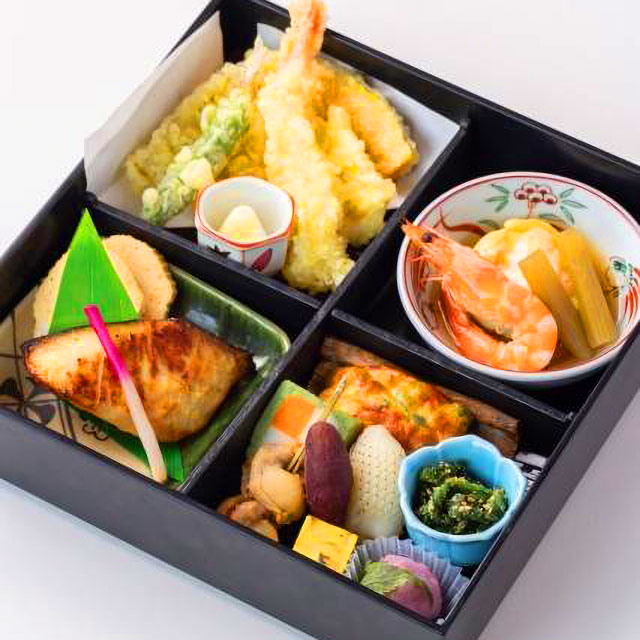
Catered Meals
A catering culture nurtured by the townspeople
It is said that in the old days, every town had at least two or three catering shops, making catering a culture that grew alongside the townspeople.
Every morning, they would shoulder their balance poles and make their rounds to the large shops along Muromachi Street and Nishijin to take orders. When the shop owner said. “Bring us a few of your best dishes today,” they would deliver the prepared food by evening. Such scenes were a common sight in daily life.
Indeed, the catering service was like another kitchen for the neighborhood.
For example, when I was child, Kyoto had a custom called “sanitation cleaning.”
On a summer day after the rainy season ends, the entire neighborhood conducts a thorough, simultaneous cleanup.
Neighbors helped each other out, tearing up the tatami mats in each house to beat out the dust and wiping down the ceilings – doing the deep cleaning that usually gets neglected. But come evening, every household invariably ordered takeout from a caterer.
And the food they delivered wasn’t anything fancy like what you’d serve guests – just the usual fare: kombu maki, soup, rice, and maybe two other ordinary side dishes.
Ordering takeout. I don’t think there was any stiff, formal air about it.
Ordering takeout was a common practice not only for the owners of large stores but also for ordinary people.
Sometimes, catering services would bring all the ingredients and cooking utensils to the customer’s home and cook right in front of them.
Caterers also know their tricks of the trade, never neglecting thoughtful touches like adjusting seasoning according to the customers.
Furthermore, since catered meals are served cold after being prepared some-time prior, meticulous planning is required to ensure they remain delicious even when cooled.
Moreover, the proprietors of large establishments have refined palates and make detailed requests regarding flavors.
However, it is precisely this training that hones the skills of the cooks.
The proprietors of establishments in Muromachi and Nishijin trust such catering services, allowing them to confidently serve catered meals when hosting events like new kimono and obi unveilings for their valued customers.
In this way, Kyoto’s traditional catering culture developed under the close relationship between customers and cooks.
Kyoto people’s tendency to splurge on special occasions and hospitality through catered meals
The deeply rooted culture of catering in Kyoto is significantly influenced by the unique spending habits of its residents, a factor that cannot be overlooked.
Kyoto residents typically lead quiet, frugal lives, yet they possess a uniquely Kyoto trait of wanting to indulge in extravagance on special occasions like celebrations or when hosting guests. This desire to show off fueled the development of the catering culture.
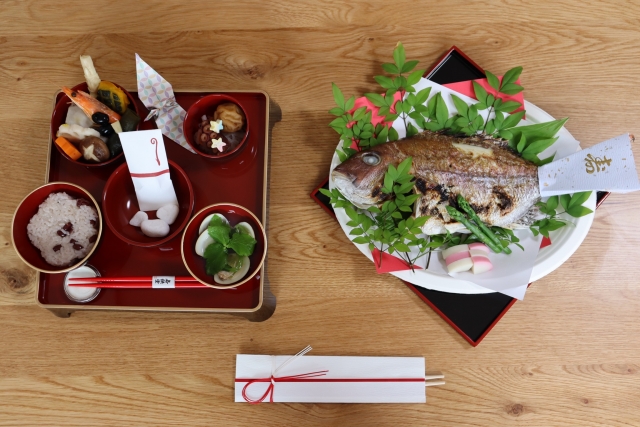
They splurge on catering for special occasions like seasonal festivals and first-food ceremonies.
For example, in the case of a neighbor of me, they purchased an expensive Buddhist altar and, wanting acquaintances to see it, invited everyone in the neighborhood and treated them to high-end catered food.
My entire family was invited to the home for a meal, but that was precisely a typical example of the Kyoto people’s show-off mentality.
To begin with, in Kyoto, there’s an unwritten rule that when guests come over, they don’t serve homemade food.
No matter how skilled a cook may be, home cooking has its own unique flavor specific to each household.
It’s only natural that sometimes it won’t suit a guest’s taste.
It would be a shame if they served them food they didn’t like.
That’s why leaving it to a professional chef is so reassuring – they’ll create flavors that appeal to everyone, so they can confidently serve it to their guests.
In Kyoto, it is considered proper hospitality to have even a single cup of coffee delivered from a coffee shop when serving guests.
Their valued guests should savor the taste crafted by seasoned professionals. This is the spirit of Kyoto hospitality. It is proper etiquette to treat everything with professional skill – that is, the very best they can offer. This is the Kyoto spirit: serving guests based on such values.
Rakuchu people, in particular, have strong tendency for it.
At memorial services and such, the sight of relatives gathered together around a catered meal is quite commonplace in Kyoto.
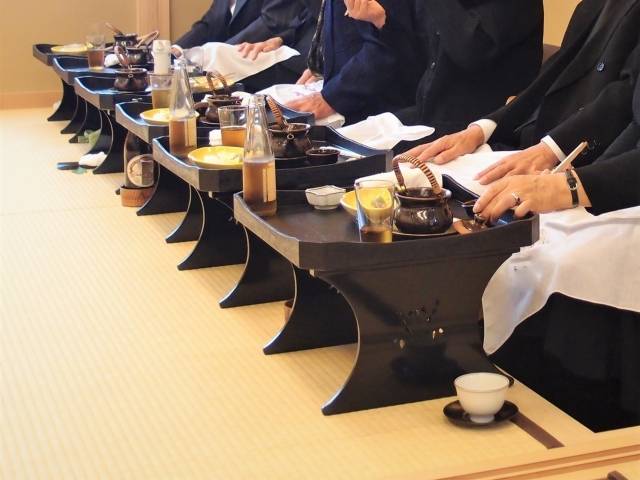
People gathered around the meal tray at the memorial service
Catered meals were convenient for both celebrations and condolences.
Why is this catering culture changing so dramatically?
I had the opportunity to read an interview article with the fifth-generation owner of Hishiiwa, a long-established catering business with over 200 years of history.
It said, “Recently, demand for catering services has plummeted.”
It continued, “Offering catered meals and boxed lunches as part of the “culture” to business hotels and private lodgings provides tourists with opportunities to experience Kyoto’s traditional culture that enriches both special occasions and daily life. I also said, “We are working with lodging facilities to develop menus tailored to guests’ needs, while also experimenting with unique twists on traditional Kyoto cuisine to appeal to foreign visitors.”
At the same time, it is also mentioned that delivering directly to guest rooms in private lodgings and business hotels allows foreign guests to enjoy dishes served in elegant tableware, while the collection system unique to non-disposable catering services is appreciated by environmentally conscious guests.
That said, upon reading this, the immediate impression the columnist had was as follows.
Even if they cater to guests’ needs, they’re ultimately just one-time visitors, aren’t they?
The style of cultivating mutual trust by refining culinary skills to meet the demands of discerning customers – the very foundation that nurtured traditional catering culture – is fundamentally opposed to catering to transient guests at private lodgings or business hotels, isn’t it?
No matter how I spin it, the reality is that Kyoto’s catering businesses are now facing a crisis of survival.
Otherwise, Kyoto’s leading traditional catering establishments wouldn’t go out of their way to deliver to the private lodgings or business hotels around Shijo Omiya.
While ostensibly partnering with private lodging operators to understand guests’ needs, in reality, most private lodging owners are Chinese.
They buy up abandoned houses, leave the renovations to contractors, and then promptly return to China.
The owners of the private lodgings themselves are not in Japan.
Is partnering with facilities that essentially run on autopilot, continuously accommodating guests without proper oversight, truly beneficial for the authentic catering culture?
In this day and age when the custom of ordering catered meals for celebrations and condolences is fading away, is this method the only one left for the catering culture to survive?
It’s gotten a bit long, but that’s the candid impression of me who witnessed the drastic changes in the catering culture in an area crowded with private lodgings and business hotels.
References
1: “Understanding Nishijin, Then Understand Japan” by Yoshikawa Tetushi, 1990, Asahi Shinsho
2: The Spirit of Hospitality Alive in Kyoto Life; ‘Catering’ 2021 Kyoto Tourism Navi Plus
3: Kyoto Hospitality Cuisine: The Catering Culture Nurtured by Townspeople and Temples, Kyoto Shimbun Co., Ltd. (ed.) 1999 Kyoto Shimbun Co., Ltd.
Author
つばくろ(Tsubakuro)
I was born and raised in Kyoto and am a native Kyotoite.
When I was young, I longed to visit Tokyo and Osaka, which are more bustling than Kyoto, but as I have gotten older, I have come to appreciate Kyoto a little more.
In this site, I will introduce you to some of the best places to explore Kyoto's food that you might otherwise miss at first glance.




